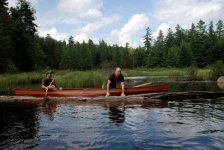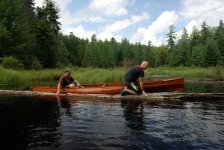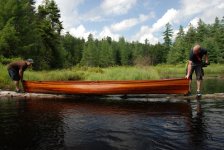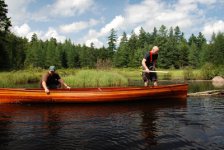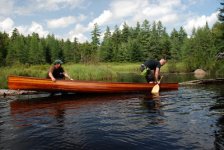G
Guest
Guest
I removed my PFD twice a few weeks ago on a swamp run for yet another reason; two of the limbo logs that day were so low that I couldn’t squeeze under with my PFD on. Not the ideal time to be taking the PFD off, but I saw one of my companions nearly flip when his PFD held him up midway under a limbo log.
I paddle a lot of narrow swamp rivers, where multiple strainers are the norm. Some of those require an out-of-boat carry around, but some can be more easily managed but crossing over or ducking under.
I think of “speed bump” logs as being submerged or partially submerged logs, where some vigorous paddling at the right spot will carry the canoe over. Or at least over enough that a lean forward or paddle push will send me on my way without getting out of the boat.
I know this is not good practice with some composite lay ups, and have broken a UL canoe doing that that (the sun was setting fast and I needed to get to the take out, get flashlights and paddle back to find some slowpoke companions. Companions who couldn’t quite grasp the concept of “Paddle, paddle, PADDLE HARD” all the way up and over the log).
Judging the out-of-water depth and consequence is the crux of a speed bump log. If you don’t make it all the way over what’s your next move? Having the hull turn sideways in the current isn’t a good option.
“Limbo Logs” to me are those fallen trees with enough clearance to permit in-boat passage, sometimes with a bit of contortionist crouching. Those can be a little dicier, especially if you find out half way under that the boat will fit but you won’t.
I’ll only attempt limbo logs of questionable clearance at a 90 degree angle in water slow enough that I know I can push the canoe back out without turning sideways if I get caught. And on the whole I’d prefer to limbo while in the seat or kneeling, so my body is still braced and I have some paddle control; laying in the bottom of the hull is a risky, last resort move that makes me anxious.
I guess there is a third variety of near-water log. Step out and on logs; big, solid partially submerged logs that are too high to speedbump over. In slow moving deep water the easiest way across is to tuck in sideways, hop out atop the log, haul the canoe over and re-enter on the downstream side. This can also be a dicey move; slippery logs, a loss of balance, a little more current than expected, can’t get the boat quite parallel to the log on the downstream side, painter lines not long enough. And of course getting back into the canoe with paddle control before floating into the next obstacle.
Those of you who are swampers or who paddle heavily strainered stuff, what do you do? What do you call those obstacles?


